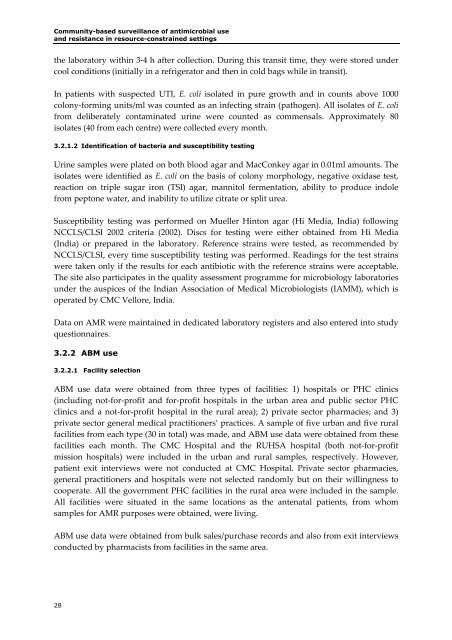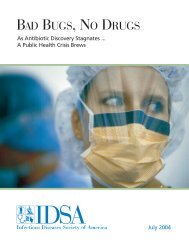Community-Based Surveillance of Antimicrobial Use and ...
Community-Based Surveillance of Antimicrobial Use and ...
Community-Based Surveillance of Antimicrobial Use and ...
- No tags were found...
You also want an ePaper? Increase the reach of your titles
YUMPU automatically turns print PDFs into web optimized ePapers that Google loves.
<strong>Community</strong>-based surveillance <strong>of</strong> antimicrobial use<strong>and</strong> resistance in resource-constrained settingsthe laboratory within 3‐4 h after collection. During this transit time, they were stored undercool conditions (initially in a refrigerator <strong>and</strong> then in cold bags while in transit).In patients with suspected UTI, E. coli isolated in pure growth <strong>and</strong> in counts above 1000colony‐forming units/ml was counted as an infecting strain (pathogen). All isolates <strong>of</strong> E. colifrom deliberately contaminated urine were counted as commensals. Approximately 80isolates (40 from each centre) were collected every month.3.2.1.2 Identification <strong>of</strong> bacteria <strong>and</strong> susceptibility testingUrine samples were plated on both blood agar <strong>and</strong> MacConkey agar in 0.01ml amounts. Theisolates were identified as E. coli on the basis <strong>of</strong> colony morphology, negative oxidase test,reaction on triple sugar iron (TSI) agar, mannitol fermentation, ability to produce indolefrom peptone water, <strong>and</strong> inability to utilize citrate or split urea.Susceptibility testing was performed on Mueller Hinton agar (Hi Media, India) followingNCCLS/CLSI 2002 criteria (2002). Discs for testing were either obtained from Hi Media(India) or prepared in the laboratory. Reference strains were tested, as recommended byNCCLS/CLSI, every time susceptibility testing was performed. Readings for the test strainswere taken only if the results for each antibiotic with the reference strains were acceptable.The site also participates in the quality assessment programme for microbiology laboratoriesunder the auspices <strong>of</strong> the Indian Association <strong>of</strong> Medical Microbiologists (IAMM), which isoperated by CMC Vellore, India.Data on AMR were maintained in dedicated laboratory registers <strong>and</strong> also entered into studyquestionnaires.3.2.2 ABM use3.2.2.1 Facility selectionABM use data were obtained from three types <strong>of</strong> facilities: 1) hospitals or PHC clinics(including not‐for‐pr<strong>of</strong>it <strong>and</strong> for‐pr<strong>of</strong>it hospitals in the urban area <strong>and</strong> public sector PHCclinics <strong>and</strong> a not‐for‐pr<strong>of</strong>it hospital in the rural area); 2) private sector pharmacies; <strong>and</strong> 3)private sector general medical practitioners’ practices. A sample <strong>of</strong> five urban <strong>and</strong> five ruralfacilities from each type (30 in total) was made, <strong>and</strong> ABM use data were obtained from thesefacilities each month. The CMC Hospital <strong>and</strong> the RUHSA hospital (both not‐for‐pr<strong>of</strong>itmission hospitals) were included in the urban <strong>and</strong> rural samples, respectively. However,patient exit interviews were not conducted at CMC Hospital. Private sector pharmacies,general practitioners <strong>and</strong> hospitals were not selected r<strong>and</strong>omly but on their willingness tocooperate. All the government PHC facilities in the rural area were included in the sample.All facilities were situated in the same locations as the antenatal patients, from whomsamples for AMR purposes were obtained, were living.ABM use data were obtained from bulk sales/purchase records <strong>and</strong> also from exit interviewsconducted by pharmacists from facilities in the same area.28




